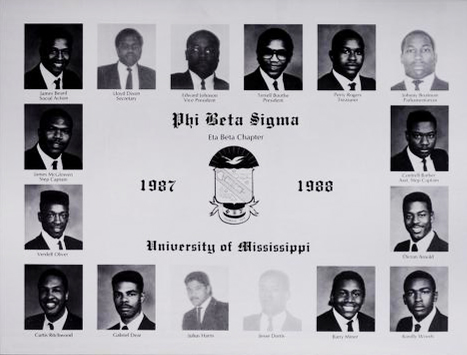The empty lot on Fraternity Row between Pi Kappa Phi and Phi Delta Theta has a history unknown to many students. The property still belongs to a National Pan-Hellenic Council fraternity whose original house was burned down in a suspected act of racially motivated arson before any of the brothers could move in.
The Phi Beta Sigma fraternity house, home to “the Sigmas,” was lit up in flames the night of Aug. 4, 1988.
To this day, there is no black fraternity or sorority house on the Ole Miss campus.

Ole Miss Phi Beta Sigma Eta Beta Chapter of 1987-1988. Photo courtesy: the Ole Miss yearbook
The Associate Dean of Students in 1988, Thomas “Sparky” Reardon, was the first to get a phone call and arrive on the scene. He said that was one of the hardest days he’s ever had to face. According to Reardon, the house was then located on the corner of Chucky Mullins and Fraternity row, now claimed by the Phi Kappa Psi extension.
“There are so many black students who love (the University of Mississippi), and defend it, and have to reassure their grandmothers that it’s okay for them to be here and it’s safe and then something like this happens,” Reardon said. “Where was the anger? Rednecks? Fraternity men? I don’t think we ever had a lead.”
Although there were speculations about who may have committed the crime, the act remains unsolved. According to Davii Jo Chinault, administrative assistant at the Oxford Fire Department, there is no current record of the incident because it happened long before the current computer system was installed for record keeping.
“Older people tell us that it was either the KKK or a white fraternity,”said Cellas Hayes, the current president of the Eta Beta Chapter of phi Beta Sigma Fraternity, Incorporated said.
The Sigma house fire is just one of many race-related incidents that the university faced after its turbulent struggle with adopting Civil Rights on campus in the 20th century.
“It just seemed like the campus couldn’t get away from those things,” Reardon said. “We have a history of doing stupid things that embarrassed us. It just felt like every two years we would get kicked down and something would happen.”
According to the New York Times article published Oct. 16, 1988, the Chancellor’s office and Interfraternity Council raised $20,000 to help the Sigmas recover and “find an alternative on Fraternity Row.” An anonymous alumnus wrote a $100,000 check to the Eta Beta chapter of Phi Beta Sigma, and the university offered a $6,000 reward for the arrest and prosecution of the arsonist, but no arrest was ever made.
The Eta Beta chapter invested the money into a lease on the plot of land between Pi Kappa Phi and Phi Delta Theta. According to Hayes, it took 20 years for the fraternity to pay for the lease.
Reardon said the history of the Phi Beta Sigma fire is important to the UM community and that he hopes this awareness can prevent the campus from repeating this painful history.
“People who don’t know their past are doomed to repeat it,” Reardon said. “We take for granted that we are the way we are, and it was a painless path to get here. When in reality, we are the way we are because some history has been painful, but others worth celebrating.”
THE HISTORY
Phi Beta Sigma was chartered on campus in 1975, 10 years after James Meredith integrated the University of Mississippi, but the chapter not have a plot of land on campus at the time.
Reardon was largely involved with the negotiations to get the Phi Beta Sigma fraternity house a vacant lot along Fraternity Row, along with Gerald Turner, the Chancellor of the University of Mississippi in 1988, and Thomas Wallace, the vice chancellor for student affairs.
Reardon said there was a perceived resistance to the establishment of the Sigma house on campus, but a lot of students understood it was time to further integrate campus.
“There were more doubters than resistance. People would bring up reasons why it wouldn’t work to integrate Fraternity Row, and they were stupid reasons,” Reardon said.
When the house was burned to the ground that August, many people made contributions in an effort to help the Sigmas’ chapter, but without a house they were at a disadvantage.
Associate professor of political science and African-American studies Marvin King said the Sigmas had a great disadvantage because they didn’t have a common place to bring their brothers together for meetings and meal times like the IFC greek organizations on campus.
“They’re functionally not able to operate the way any other Greek organization could,” King said.
TODAY
The fraternity is still active and hoping to one day return to campus with a house of its own.
Hayes said NPHC chapters are typically much smaller than IFC and NPC organizations. Hayes said this semester, the Eta Beta Chapter of Phi Beta Sigma has 14 members, and they generally bring in five to 10 members each year.
He also said each member pays $150 per semester, so for the Sigmas to build a house, the alumnae would have to make a majority of the contribution unless the dues increased significantly for each active member.
According to Reardon, the university by law cannot contribute to private organizations for a house on campus. Each affiliation is responsible for all costs of their own house.
Hayes said there’s a lack of knowledge about NPHC organizations at the University of Mississippi. He said NPHC fraternities have the same goals as those of IFC chapters, but the difference is that 14 members of an NPHC organization are doing what 300 members in an IFC organization do.
“Ole Miss is a predominantly white institution,” Hayes said. “It’s the culture of the environment being the majority you don’t have to worry about the minority. Minorities have to cater to the majority.”






